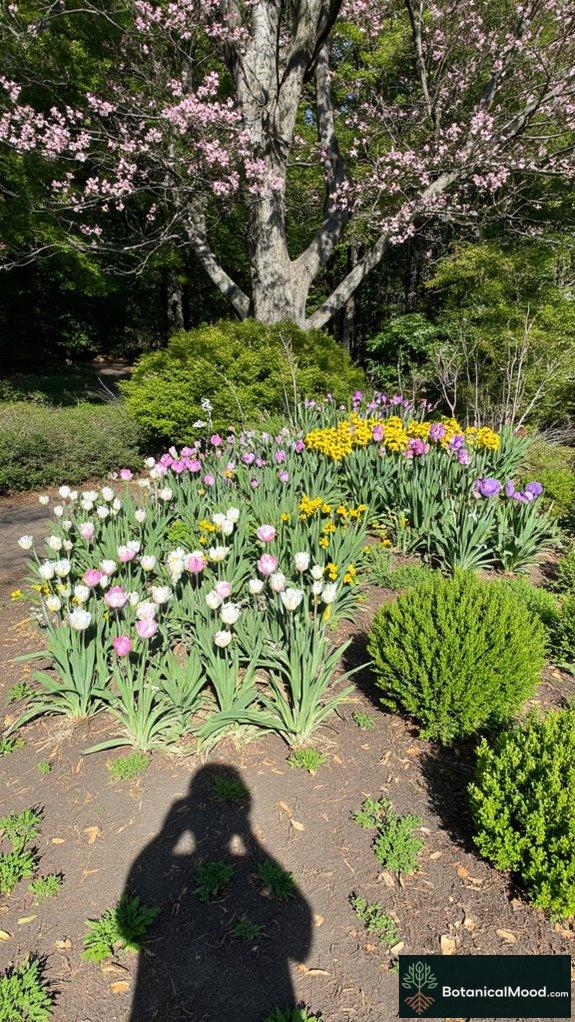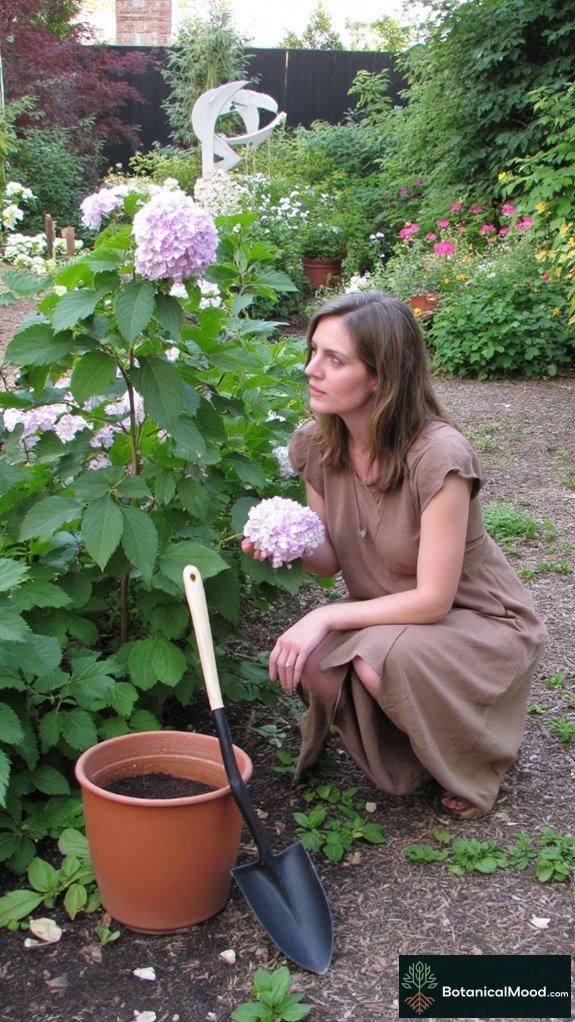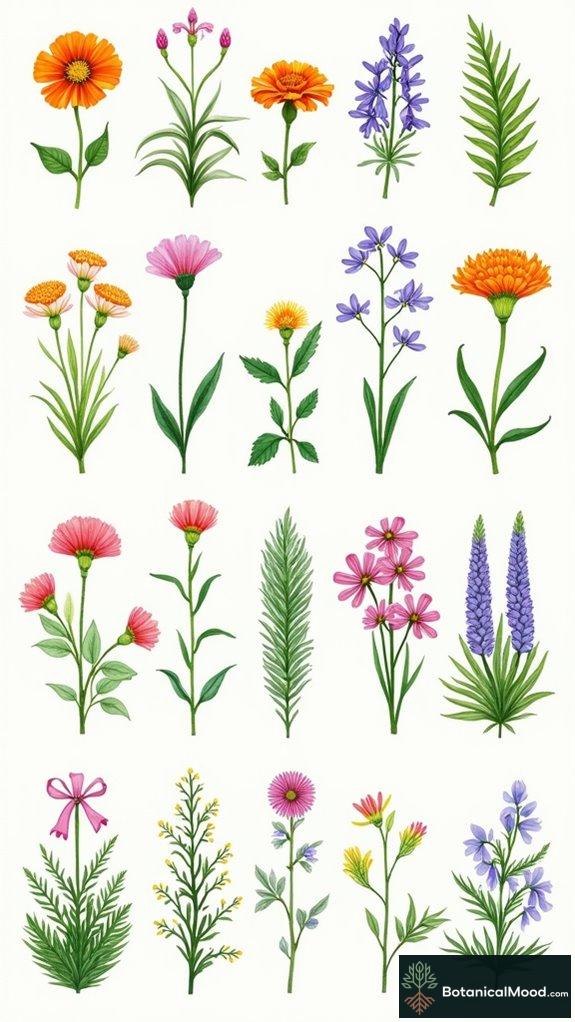There’s something utterly magical about a vibrant garden that feels like a scene out of a fairy tale.
I learned this the hard way—my first attempt featured an unholy mix of Echinacea and a few sad Pansies. Let’s just say it looked more like a circus than a cohesive palette.
Now, I dive deeper into the seasonal color wheel. I layer plants with varying heights, toss in some hardy shrubs, and use lush ground covers like they’d gone out of style. Oh, and you can’t forget the hardscape elements—natural pavers are a must for keeping it all in harmony.
Have you ever poured your heart into garden design only to wonder if you should’ve just planted weeds instead?
It can be a rollercoaster!
The Joys and Challenges of Layering Plants: A Personal Journey
When I decided to transform my backyard, I was clueless but excited. I remember standing amidst towering azaleas and wanting to layer stunning colors. It was a whirlwind of ordering perennials, frantically Googling heights, and getting lost in plant catalogs.
One day, I planted a weeping cherry tree, thinking it would be the showstopper. Spoiler alert: it was. But beneath it, I tucked vibrant bulbs and soft ferns, creating an underworld of delight. The layers added a visual feast!
So, if you’re hesitating about garden design—relax! It’s an evolving masterpiece filled with joy, surprise, and yes, even a bit of chaos.
Quick Takeaways
- Select seasonal perennials like Echinacea and Sedum for durable beauty that enhances your garden’s vibrant color palette year-round.
- Incorporate complementary color schemes using plants like Geraniums and Begonias to create striking contrasts and harmonious visual appeal.
- Layer plants of varying heights to add depth, using tall Delphiniums, medium Asters, and low Sedums for a captivating garden design.
- Enhance your garden space with hardscape elements like pathways and retaining walls, which complement and unify your vibrant plant colors.
- Utilize plants that require minimal care, such as Geraniums, to ensure continuous blooms and seasonal color without extensive maintenance.
Understanding the Seasonal Color Wheel for Garden Design

To create a vibrant and cohesive garden that truly reflects the beauty of nature, understanding the seasonal color wheel is essential.
I’ve found that each season breathes its own array of colors into the scenery, from the crisp whites and soft pastels of spring blooms to the warm, fiery hues of autumn foliage.
Each season paints the garden with its unique palette, from spring’s delicate pastels to autumn’s vibrant warmth.
By selecting plants that harmonize with these seasonal shifts, like seasonal perennials and hardy shrubs, I enhance the garden’s allure.
Incorporating color theory not only guides my choices but weaves a story throughout the year, ensuring my garden feels alive and radiant, just as I envisioned when guiding Botanical Mood’s essence.
Additionally, understanding seasonal transition gardening can inspire new ideas as you shift from spring to summer blooms.
Exploring Key Color Schemes for Your Garden

How can the right color scheme transform your garden into a harmonious sanctuary? Utilizing complementary color plantings can create striking contrasts that enhance the beauty of your landscape.
Selecting Plants for Year-Round Color Consistency

Creating an inviting garden space requires more than just appealing aesthetics; it demands a thoughtful selection of plants that work in harmony year-round.
To guarantee vibrant colors throughout the seasons, consider these key choices:
- Perennials: Think Echinacea or Sedum for endurance and beauty, blooming year after year.
- Evergreens: Use varieties like Juniper or Boxwood to maintain structure and lush greenery in winter, providing a backdrop for seasonal color.
- Seasonal Annuals: Embrace Pansies in spring and vibrant Marigolds in summer, adding splashes of color while maintaining continuity.
Incorporating edible landscape strategies can enhance your garden’s productivity while keeping it visually appealing.
Enhancing Depth With Texture and Height Variations

While depth and dimension often enhance the overall appeal of a garden, understanding how to incorporate texture and height variations is essential for creating a visually stimulating environment.
I love arranging plants in layers, using towering sunflowers alongside sprawling groundcovers. Here’s a simple guide to inspire your choices:
| Height | Texture | Examples |
|---|---|---|
| Tall | Bold | Delphiniums, Foxgloves |
| Medium | Soft | Asters, Lavender |
| Low | Textured | Sedums, Creeping Phlox |
| Ground Cover | Dense | Thyme, Creeping Juniper |
These layers invite exploration, revealing delightful surprises throughout the seasons. Incorporating height layering techniques allows for a striking and harmonious garden design that captivates the senses.
Integrating Hardscape Elements Into Your Color Palette

Integrating hardscape elements into your color palette can transform your garden into a cohesive masterpiece, especially when you thoughtfully select materials that harmonize with your plant choices.
Here’s what you can consider:
- Pavers and Pathways: Choose warm-hued natural stone or crisp white pavers that complement blooming flowers.
- Retaining Walls: Use weathered wood or rustic bricks that echo earthy tones, enriching the overall look of your space.
- Garden Furniture: Select finishes in muted colors to enhance rather than compete, inviting you to linger among your flourishing greenery.
These choices deepen connections in your garden, nurturing an inviting atmosphere.
Choosing the Right Plant Varieties for Your Climate

Understanding your local climate is essential when selecting plant varieties, as it can greatly affect not only the health and longevity of your garden but also its aesthetic appeal.
For instance, if you live in a warm, arid region, consider drought-resistant plants like lavender or succulents.
Conversely, if you’re nestled in a cooler, shaded area, ferns and hostas can thrive beautifully.
Always check your USDA Plant Hardiness Zone to guide your choices.
Embracing the right varieties not only enhances your garden’s vibrancy but also guarantees it flourishes year after year—something I deeply cherish in garden design.
Vibrant Floral Arrangement Techniques

Crafting vibrant floral arrangements is one of the most enchanting aspects of garden design, as it allows me to express creativity and invoke emotion through color and texture. To master this art, I focus on these essential techniques:
- Grid technique: Using tape across the vase opening to hold flowers securely, ensuring a beautifully structured display.
- Spiral technique: Arranging stems in a spiral for a natural balance and flow, creating an elegant aesthetic.
- Negative space: Embracing empty areas to let blooms breathe and shine, enhancing the overall impact of each arrangement. Understanding the colour wheel is crucial for creating harmonious color palettes that make your arrangements pop.
These thoughtful approaches enhance my love for floral design, as showcased on my site, Botanical Mood.
Seasonal Color Coordination Layout

Creating a seasonal color coordination layout for your garden not only enhances its aesthetic appeal but also fosters a thriving environment that reflects the beauty of nature throughout the year.
I love employing complementary schemes—like vibrant reds and lush greens—contrasting with harmonious analogues for depth. Each plant I choose not only flourishes in my USDA zone but also understands timing, ensuring overlapping blooms.
Textural variation is key, too; combining perennials for structure with annuals for pops of color creates an inviting scene.
Observing shifts through colors, like fiery autumn reds or serene winter whites, feels like a dance of seasonal beauty.
Meet the Garden’s Creator

The garden’s creator, Coffin, hails from Winterthur, Delaware, where her passion for blending nature and design led her to pursue a career in environmental design, inspired by the beauty of formal gardens.
Coffin, a Winterthur native, infuses her environmental design career with a passion for formal gardens and nature’s beauty.
To realize her garden vision, Coffin meticulously planned each section, applying her formal training in environmental design and collaborating with horticulturists like Henry Francis du Pont, ensuring a harmonious blend of plant varieties and structural elements.
Coffin utilized tools like trowels and garden hoes, accessorized with handcrafted sundials and terracotta pots.
She favored brands such as Fiskars for garden tools and sought inspiration from renowned horticulturists, ensuring her garden reflected both artistry and scientific precision.
Popular Annual Blooms

While planning my garden, I’ve come to appreciate the vibrant impact that popular annual blooms can add to any scenery, transforming it into a lively and colorful haven.
Here are three of my favorite annuals that truly shine:
- Petunia: This beauty brings a burst of color and works wonderfully in both beds and containers.
- Geranium: Known for its resilience, it adds charm with its vibrant blooms and variety of colors.
- Begonia: With its lush foliage and delicate flowers, it’s perfect for shaded areas, effortlessly brightening any spot.
These blooms create an enchanting atmosphere that captivates the senses.
References
- https://www.provenwinnerscolorchoice.com/picking-the-right-garden-color-scheme/
- https://colorwheelco.com/wp-content/uploads/2017/07/Gardeners-Color-Wheel-Booklet.pdf
- https://www.monrovia.com/be-inspired/garden-color-palette-guides.html
- https://www.prettypurpledoor.com/garden-color-schemes/
- https://www.summerwindsnursery.com/ca/inspire/gardens/color-theory/
- https://designerblooms.ca/blogs/flowers/flower-fun-beginners-guide-to-stunning-arrangements-in-6-steps
- https://www.wholeblossoms.com/wedding-flowers-blog/creating-vibrant-floral-arrangements-tips-for-using-color-themes-and-flower-selection/
- https://www.thefloralsociety.com/blogs/how-to-arrange-flowers/a-complete-guide-how-to-arrange-flowers
- https://twosistersflowerfarm.com/flower-arranging-tutorial/
- https://charlottepuxleyflowers.com/blogs/floral-feelings/guide-to-floral-workshops-best-flower-arrangement-techniques
- https://www.gardeners.com/how-to/garden-design-color-schemes/9366.html
- https://phsonline.org/for-gardeners/gardeners-blog/designing-garden-color-schemes
- https://www.bi-gardenantiques.com/newsletter/the-grand-dames-of-american-garden-design/
- https://www.hortmag.com/uncategorized/great-gardeners-wisdom-ideas-best
- https://www.nationaltrust.org.uk/discover/history/people/great-women-gardeners
- https://land8.com/top-10-most-influential-landscape-architects-of-all-time/
- https://npshistory.com/publications/landscapes/pioneers-am-landscape-design.pdf
- https://pmc.ncbi.nlm.nih.gov/articles/PMC11163454/
- https://www.epicgardening.com/summer-annual-flowers/
- https://wcroc.cfans.umn.edu/horticulture/2024-top-ten
- https://www.westonnurseries.com/our-12-most-popular-annuals/
- https://www.houzz.com/discussions/6400356/the-yearly-report-of-your-top-performing-annuals-and-perennials-for-23

Leave a Reply